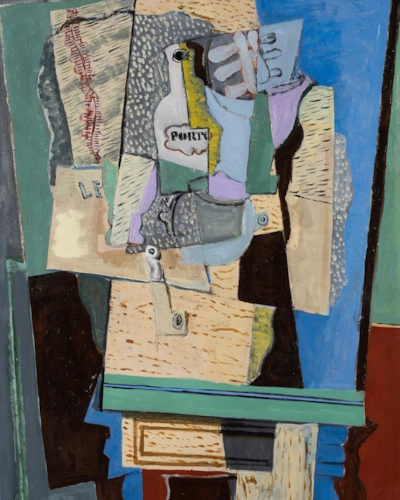Jean-Paul Riopelle
1923 - 2002
F. AC (Ficelle AC Bristol)
89.7 x 49.5 cm (35 ¹/₄ x 19 ¹/₂ inches)
Signed with initial lower right, R and titled, AC (Abstract Composition) N
Executed in 1972

Galerie Roche, Bremen, Germany
Kaspar Gallery, Toronto, Canada
Private collection, Italy
Paris, Centre culturel canadien et Musée d'art moderne, Riopelle, ficelles et autres jeux, cat. no. 76, 1972
Jean-Paul Riopelle
biography
In 1942 he enrolled at the école des Beaux-Arts in Montreal but shifted his studies to the much less academic approach at the école du Meuble, graduating in 1945. There he studied with Paul-émile Borduas, a teacher who was extremely dedicated to his students and gave them a great deal of freedom. It was under Borduas's direction that Riopelle made his first abstract painting. From 1942-45, Borduas and several of his students, including Riopelle, formed a group that worked, socialised and exhibited together. The group became known as the Automatistes for their spontaneous method of painting, which drew on the subconscious as a source.
In 1946, Riopelle first travelled to France, where he would return and settle the following year. Borduas authored the manifesto Refus global in 1948, which was signed by a number of his students, including Riopelle. Riopelle had his first solo exhibition at the Surrealist meeting place, Galerie La Dragonne in Paris, in 1949. During the late 1940s and early 1950s, he met and became friends with artists, writers and gallery owners including Georges Mathieu and Pierre Loeb, who introduced him to André Breton. He also met Jean Arp and Antonin Artaud at Loeb's gallery.
The coming years brought Riopelle increasing success and immersion in the Parisian cultural scene. He was represented in New York and participated in the biennials of contemporary art in Venice (1954) and Sao Paulo (1955). He spent his evenings in Paris bistros with friends including playwright Samuel Beckett and artist Alberto Giacometti.
In such works as Pavane (1954) and The Wheel II (1956), Riopelle pioneered a style of painting where large quantities of varied coloured paints were thickly applied to the canvas with a trowel or palette knife. Seeking to express a “mental landscape, the result of his relations with reality”, these works of lyrical abstraction show the influence of surrealism and Riopelle’s free-flowing subconscious. Spanning approximately 8 by 10 feet, The Wheel II is composed of vibrant geometric slabs of paint laid down by a palette knife, which fan out in concentric patterns and amass in a spontaneous mosaic of colour.
Of his method, Riopelle said, “Because there are no longer any widely accepted symbols, another type of relationship is necessary. For me, this is the contact with nature. The contact with nature requires documentation… for me, to create, the simplest is to draw and to gather material from nature… “
In the 1960s, Riopelle renewed his ties to Canada. Exhibitions were held at the National Gallery of Canada (1963), and the Musée du Quebec held a retrospective in 1967. In the early 1970s, he built a home and studio in the Laurentians. From 1974 he divided his time between St. Marguerite in Quebec, and Saint-Cyr-en-Arthies in France. Riopelle participated in his last exhibition in 1996. From 1994 until his death, 12 March 2002, he maintained homes in both St. Marguerite and Isle-aux-Grues, Quebec.
Jean-Paul Riopelle
biography
you may also like
1923 - 2012
Phenomena Spectrum Guardian
75.88 x 101.5 cm (29 ⁷/₈ x 40 inches)
1931 - 2004
Study for Bedroom Painting #31
20.3 x 26 cm (8 x 10 ¹/₄ inches)




















